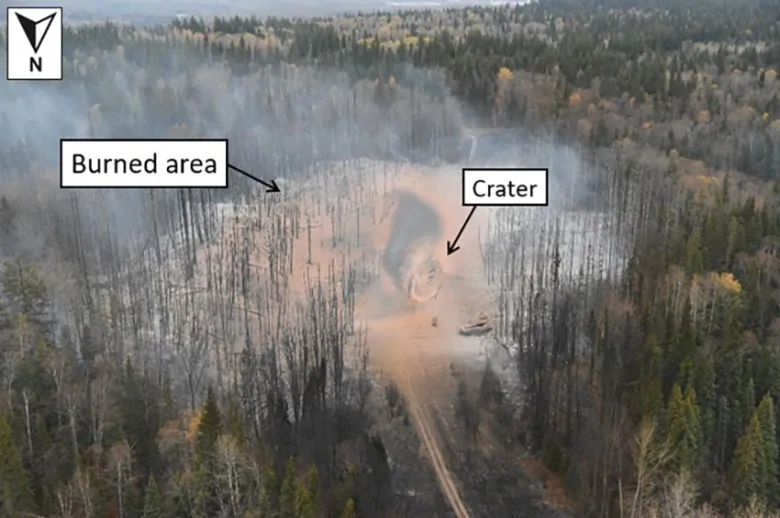Undetected stress cracks led to natural-gas pipeline explosion near Prince George, TSB finds

A pipeline explosion near Prince George, B.C., that led to dozens of evacuations and a choked natural gas supply across the province was caused by stress cracks in the pipe, an investigation from the Transportation Safety Board (TSB) has found.
The report also found the risk of the blast in Shelley, B.C., in 2018 was missed because the pipeline’s operator postponed a hazard management inspection by several months before the explosion.
No one was hurt when the 36-inch (91-centimetre) Enbridge line blew apart and caught fire on Oct. 9, 2018, but more than 100 people living within a two-kilometre radius were told to evacuate their homes as a precaution.
The amount of natural gas flowing through the province also dropped after Enbridge halted transport on the ruptured line, as well as a neighbouring 30-inch (76-centimetre) line. British Columbians were temporarily asked to avoid “non-essential” use of natural gas, with utility FortisBC only receiving 40 per cent of its usual gas flow.
Analysts later estimated about 10 per cent of Western Canada’s daily natural gas output stopped after the blast.
Pipeline cracks grew quicker than anticipated
The months-long TSB investigation found the outer surface of the pipeline was riddled with stress corrosion cracks before the explosion. The polyethylene tape used to coat the outside of the pipeline had also deteriorated over time, peeling away from the metalic surface and allowing moisture from surrounding soil to eat away at the pipe walls.
The fissures grew over time, lowering the capacity of the pipeline as it continued to run at its normal operating levels.
The pipeline was operated by Westcoast Energy Inc., a subsidiary of Enbridge. The TSB said Westcoast did have a hazard management plan in place to monitor the line for stress corrosion, but the extent of the existing cracking on the section that exploded “was not identified.”
“The model used to predict crack growth did not take into account all potential uncertainties in the predicted crack growth. This resulted in cracks growing at higher rates than the model predicted,” the report said.
On top of the unexpected crack growth, the TSB said, a pipeline inspection scheduled to happen in 2017 was deferred until the fall of 2018.
“As such, the existing cracks remained undetected,” the board said.
The blast blew a crater in the earth and burned surrounding trees, the report said. The hole in the ground was about 35 metres long, 13 metres wide and had a peak depth of about nine metres.
On Wednesday, an Enbridge senior vice-president said the company knew there was a risk of stress-corrosion cracks.
“That’s a known threat to pipeline integrity … it’s one that had been identified to look for,” Michele Harradence told CBC’s Daybreak North on Wednesday.
“In this case, despite using the best available tech that was available to inspect the pipeline at the times that we did, the rate of growth of the cracking … it grew faster than we anticipated it would.”
The Transportation Safety Board was called to investigate as the agency investigates any incident involving federally regulated modes of transport. Pipelines are regulated by the federal government and are a method of transportation for goods, though pipeline-related TSB inspections are relatively uncommon.
The board said it sent Enbridge a pipeline safety advisory after finishing the investigation, educating the company on managing stress corrosion on at-risk pipelines.
Harradence said Enbridge now has a “much more aggressive” inspection program in place.
“Significant portions of all of our B.C. system … virtually all of it has been re-inspected,” she said.
The TSB also noted a number of changes implemented by Enbridge in wake of the blast.





